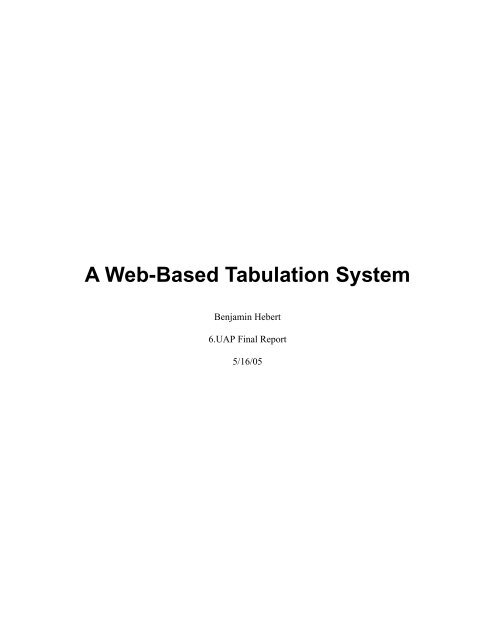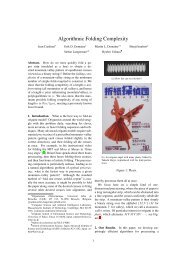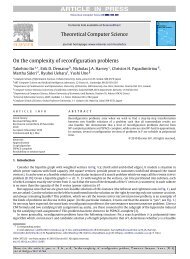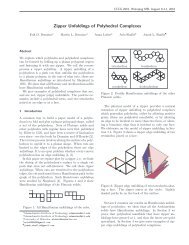A Web-Based Tabulation System - Erik Demaine
A Web-Based Tabulation System - Erik Demaine
A Web-Based Tabulation System - Erik Demaine
Create successful ePaper yourself
Turn your PDF publications into a flip-book with our unique Google optimized e-Paper software.
A <strong>Web</strong>-<strong>Based</strong> <strong>Tabulation</strong> <strong>System</strong><br />
Benjamin Hebert<br />
6.UAP Final Report<br />
5/16/05
Abstract<br />
I present a web-based system for tabulation American Parliamentary Debate<br />
Association (APDA) debate tournaments [1]. The system is designed for use by<br />
computer-literate, non-technical users. It provides tournament registration, tabulation,<br />
judge assignment, and room assignment features, in accordance with typical APDA<br />
practices [2]. The system is implemented on a web server owned by the APDA<br />
organization, and must maintain a high level of availability. The core algorithm for<br />
tabulation is the minimum-weight perfect matching algorithm [3], a well-known problem<br />
requiring polynomial time. The system uses an open-source implementation of that<br />
algorithm from the JICOS project [4].
Table of Contents<br />
1. Introduction..................................................................................................................... 5<br />
1.1 <strong>Tabulation</strong> ............................................................................................................. 5<br />
1.2 Existing Alternatives............................................................................................. 6<br />
2. <strong>System</strong> Design ................................................................................................................ 7<br />
3. Module Descriptions....................................................................................................... 8<br />
3.1 Server .................................................................................................................... 8<br />
3.2 User Interface/PHP Code...................................................................................... 8<br />
3.3 MySQL Database.................................................................................................. 9<br />
3.4 Java Code............................................................................................................ 10<br />
4. Scheduling Algorithm................................................................................................... 11<br />
5. Testing and Debugging................................................................................................. 12<br />
6. Conclusion .................................................................................................................... 13<br />
7. Acknowledgements....................................................................................................... 13<br />
8. References..................................................................................................................... 14
Figures and Tables<br />
Figure 1: <strong>System</strong> Layout..................................................................................................... 7<br />
Table 1: Tables in MySQL Database.................................................................................. 9
1. Introduction<br />
The goal of this project was to create a reliable system for tabulating tournaments.<br />
Using a “web-service” system design allows configuration of the software to be done<br />
once, on the server, rather than every time a new user wants to use the software.<br />
Moreover, it facilitates easy access and alteration of the program during tournaments, in<br />
the event of an error. Given the prevalence of reliable, high speed internet connections<br />
on college campuses, requiring internet access on the part of the user does not create a<br />
significant burden. Moreover, the web-service model will work with any computer<br />
equipped with a web-browser.<br />
1.1 <strong>Tabulation</strong><br />
<strong>Tabulation</strong> is the process by which debate teams are paired to debate each other.<br />
In a typical tournament, there are between 30 and 150 2-person debate teams,<br />
representing between 10 and 40 schools. Over the course of a 5-round tournament, teams<br />
must be paired off to debate against each other. Generally, teams will be paired against<br />
other teams with the same won-loss record thus far. Teams are also evaluated on<br />
“speaker points” and “ranks,” and teams should be paired off so that (for example) the<br />
best team with 2 wins and 1 loss debates against the worst team with 2 wins and 1 loss.<br />
However, there are a series of restrictions, ranked in order of priority, which must apply<br />
to the pairings. Teams should never debate twice, or debate against teams from the same<br />
school, etc… For a detailed description of these restrictions, see [2]. These restrictions<br />
complicate tabulation so that the process is non-trivial.
1.2 Existing Alternatives<br />
Currently, there are two means of tabulation available to the directors of debate<br />
tournaments. The first is doing it by hand—a slow, tedious, error-filled process that<br />
delays debate tournaments, requires a great deal of expertise, and invites corruption and<br />
favoritism. For schools new to the circuit, hand tabulation is difficult. For competitors,<br />
hand tabulation is frustrating because it causes long delays in the tournament and often<br />
results in inconsistent application of the stated tabulation policies.<br />
The other alternative is a computer program, the Harvard Tab Program. This<br />
program, written as an MS-Access database, is unreliable, often incorrect, and very<br />
difficult to use. It requires a specific version of MS Access to work properly, and has not<br />
been adequately tested. It is closed source, and frequently produces questionable output.<br />
It follows no clear tabulation policy. It is very difficult to use properly, and as a result<br />
there are frequent errors committed by the users, causing tournament delays.<br />
These alternatives, for the reasons listed above, do not meet the needs of the<br />
APDA community. It is my belief that reliable, well-documented software, delivered as a<br />
web service, will better suit the requirements of APDA.
2. <strong>System</strong> Design<br />
The system is designed as a web service, to be run on a server owned by APDA.<br />
The client will use a web browser and log into the APDA server, running the Apache<br />
<strong>Web</strong> Server. The user interface is written in HTML that is dynamically generated using<br />
PHP. The web pages contain information about the current state of the tournament, the<br />
results of previous rounds, and the pairings for the next round. This information is stored<br />
in a MySQL database the PHP code will access. The tabulation algorithms are written in<br />
Java; the PHP code will instantiated the appropriate top-level Java Scheduler object, and<br />
call its tabulate method as required. The Java code will use its own interface to the<br />
MySQL database. Figure 1 below illustrates the overall layout of the system.<br />
Figure 1: <strong>System</strong> Layout
3. Module Descriptions<br />
3.1 Server<br />
The APDA server will run the standard Linux environment provided by the<br />
selected internet hosting provider. The environment must have Apache, MySQL, PHP,<br />
and a Java virtual machine installed—but these features are standard for internet hosting<br />
providers. Although the system will dynamically generate and deliver many HTML<br />
pages, I do not believe the system will require excessively large amounts of bandwidth.<br />
3.2 User Interface/PHP Code<br />
The user interface (implemented as HTML pages) and the PHP code that generate<br />
it attempt to create an easy-to-use, responsive interface for the user. Because the user<br />
may have only basic computer experience, simplicity and clear design are essential. One<br />
of the advantages of implementing this system as a web service is that the interface can<br />
be created in HTML, and rapidly modified. Members of the APDA community with<br />
some web page experience will be able to contribute to the development of the interface,<br />
allowing for the more rapid and successful development of an easy-to-use program. This<br />
would not be possible if the system were implemented as a locally run program, because<br />
the GUI mechanisms of (for example) Swing are not understood by as many members of<br />
the community. This “open-source” development of the interface will allow users of the<br />
system to provide feedback about the program, and have that feedback incorporated<br />
quickly. One of the flaws with the Harvard Tab Program is that its interface was not<br />
created by someone with tournament tabulation experience, and because the source is<br />
closed, there are few means by which users can offer feedback on the interface.
3.3 MySQL Database<br />
The MySQL database stores the state of the tournament and the results of<br />
previous rounds. The advantage of using a database for this purpose (rather than storing<br />
the state and results in memory) is reliability; in the event of a program crash, the system<br />
administrator can recover the state and results from the tournament, and either restart the<br />
system or at least allow tabulation by hand.<br />
The database will contain four tables per tournament. These tables are described<br />
in Table 1 below.<br />
Name<br />
Table 1: Tables in MySQL Database<br />
Description<br />
School<br />
A list of school names, unique ids, and payment information.<br />
Team<br />
A list of team names, school ids, individual debate names, novice<br />
status, and seed information for each team<br />
Team Results<br />
A ranked list of team results. This table is cleared and generated when<br />
updated team rankings are required.<br />
Round<br />
A list of rounds in the tournament. This contains past rounds, with<br />
results, and the current pairings.<br />
The School and Team table are created during the tournament registration<br />
process. As schools sign up for the tournament, their registered teams will be entered<br />
into the Team table, and a new entry created in the School table. New entries in the
Team Results table are created every time the PHP code calls the appropriate Java object.<br />
The PHP code will then display those results. New entries in the Round table are created<br />
by the Scheduler Java object, when it is called upon to generate new pairings. These<br />
entries are then updated by the PHP code, as part of the result entry process.<br />
3.4 Java Code<br />
The java code consists primarily of four objects: the Scheduler, the Team object,<br />
the DBLoader, and the ResultsGenerator. The DBLoader loads information from the<br />
Round table in the database into a list of Team objects. Each Team object contains the<br />
record, speaker scores, and other relevant information for each team. The<br />
ResultsGenerator updated the TeamResults table, by running a sort on the Team list. The<br />
Team object implements the Comparable interface, so that this sort can be accomplished<br />
using a call to Collections.sort. The ResultsGenerator calls the DBLoader to write the<br />
team results back into the database, where they can be read by the PHP code. The<br />
Scheduler operates in a similar, albeit more complex, fashion. The Scheduler object<br />
takes the list of Team objects, and generates a Map object pairing off the teams. The<br />
DBLoader then writes this Map object back into the database.<br />
The Scheduler object is actually an abstract class; currently, there are four<br />
implementations. The exponential scheduler runs a naïve exponential-time scheduling<br />
algorithm. This algorithm is very slow for even moderately size tournaments, so it is<br />
used only as a reference. The swap scheduler runs a polynomial time algorithm that<br />
creates an initial pairings, and then swaps teams as it attempts to improve the results. The<br />
JICOS scheduler runs a polynomial time minimum-weight maximum-cardinality
matching algorithm. The combined scheduler runs both the swap and JICOS schedulers,<br />
and returns the better result. The algorithm for the scheduler is described in section 4.<br />
4. Scheduling Algorithm<br />
The scheduling algorithm operates in two phases. First, it creates brackets. A<br />
bracket is a group of teams with the same won-loss record. Sometimes, it is necessary to<br />
“pull-up” a team from the bracket below (one less win) to ensure an even number of<br />
teams in the bracket. If there are an odd number of teams in the lowest bracket (no wins),<br />
the worst team in that bracket receives a bye.<br />
The system then pairs each bracket, from highest (most wins) to lowest (least<br />
wins). The pairings of each bracket are assigned a weight; the lower the weight, the<br />
better the pairing. The weight of each pairings is determined as follows: first, a squareddistance<br />
metric is used based on position within the bracket. In a 16 team bracket, the 2 nd<br />
best team paired with the 15 th best team generates a 0 weight. The 2 nd best team with the<br />
14 th best or 16 th best generates a 1 weight. The 2 nd best team paired with the 13 th best<br />
team generates a 4 weight, and so on. Next, a weight is added if one of the four tab<br />
priorities is violated. There are maximum of 256 teams in each bracket, so the total cost<br />
of all the squared weights will not exceed 256 3 . We add a power of 256 (3,4,5, or 6,<br />
depending on priority) if one of the tab priorities have been violated. This way, a set of<br />
pairings where a tab priority has been violated cannot be lower weight than a set of<br />
pairings where the priority has not been violated.<br />
The goal of scheduling algorithm is to produce the minimum weight pairings. For<br />
each bracket, the weight between each possible pair of teams is computed, and a
weighted, undirected graph created. The minimum-weight maximum-cardinality<br />
matching algorithm from JICOS is then run, and a pairing produced.<br />
In the event that a pull-up is required, a pairings is produced for every possible<br />
pull-up team. An additional weight is added based on that pull-up team’s distance from<br />
the center of its original bracket and whether the team has been pulled up before. The<br />
pull-up team that generates the lowest total weight is chosen, and then the lower bracket<br />
is paired, until all brackets have been paired.<br />
5. Testing and Debugging<br />
The system has been tested in several ways. First, JUnit-based unit tests have<br />
been used to verify that individual Java objects are behaving as specified. Second, a<br />
sample tournament has been run by hand, to qualitatively verify that the pairings are<br />
being correctly generated. Third, both the swap and JICOS schedulers are run, and the<br />
best pairing used. In all cases, this should be the JICOS scheduler, but the swap-based<br />
algorithm provides redundancy in the event of an error. Fourth, an automated tournament<br />
generation system has been created; the system generates results for each round in the<br />
tournament randomly. This allows both manual and automated testing: it speeds up<br />
manual tests, because with the click of a button a tester can generate results for one round<br />
and create pairings for the next round, and then manually verify that the pairings are<br />
correct. The automated testing system runs the result generator, and attempts to detect<br />
scheduling errors and violations of the tab priorities. This is more difficult—it is hard to<br />
verify pairings are correct without attempting to generate correct pairings! Nevertheless,<br />
some automated error detection is possible.
6. Conclusion<br />
The creation of an open-source, easy-to-use, reliable tabulation system should be<br />
a boon to the APDA community. Although the algorithms involved are non-trivial,<br />
interface design is challenging, and the system has a number of components, this<br />
software will be easier to maintain and more reliable than existing alternatives. Using a<br />
web-based system for tournament tabulation should help improve the timing and<br />
efficiency of APDA tournaments. APDA is fortunate that its rules of tournament<br />
scheduling do not require an algorithm of exponential complexity; although the<br />
minimum-cost maximum cardinality matching problem is a very complex polynomial<br />
time algorithm, it can be feasibly run on the size of tournaments typical of APDA.<br />
7. Acknowledgements<br />
I would like to thank several people for their invaluable assistance on this project.<br />
First, Patrick Nichols, formerly of the MIT Debate Team, for the idea of creating a webservice<br />
style tab program. Secondly, Jason Wen of the Harvard Debate Team, for<br />
assistance testing the scheduling program. Finally, I would like to thank Professor <strong>Erik</strong><br />
<strong>Demaine</strong> of MIT for supervising the project.
8. References<br />
[1] The American Parliamentary Debate Association, www.apdaweb.org<br />
[2] Swarthmore Debate Team, “APDA Nationals 2004 Tab Policy”,<br />
http://www.sccs.swarthmore.edu/org/debate/nationals2004/tab/pairings_awards.html,<br />
accessed on 5/16/05.<br />
[3] Gondran, Graphs and Algorithms, Wiley & Sons Ltd., New York, NY 1984<br />
[4] The JICOS Project, http://www.cs.ucsb.edu/projects/jicos
















